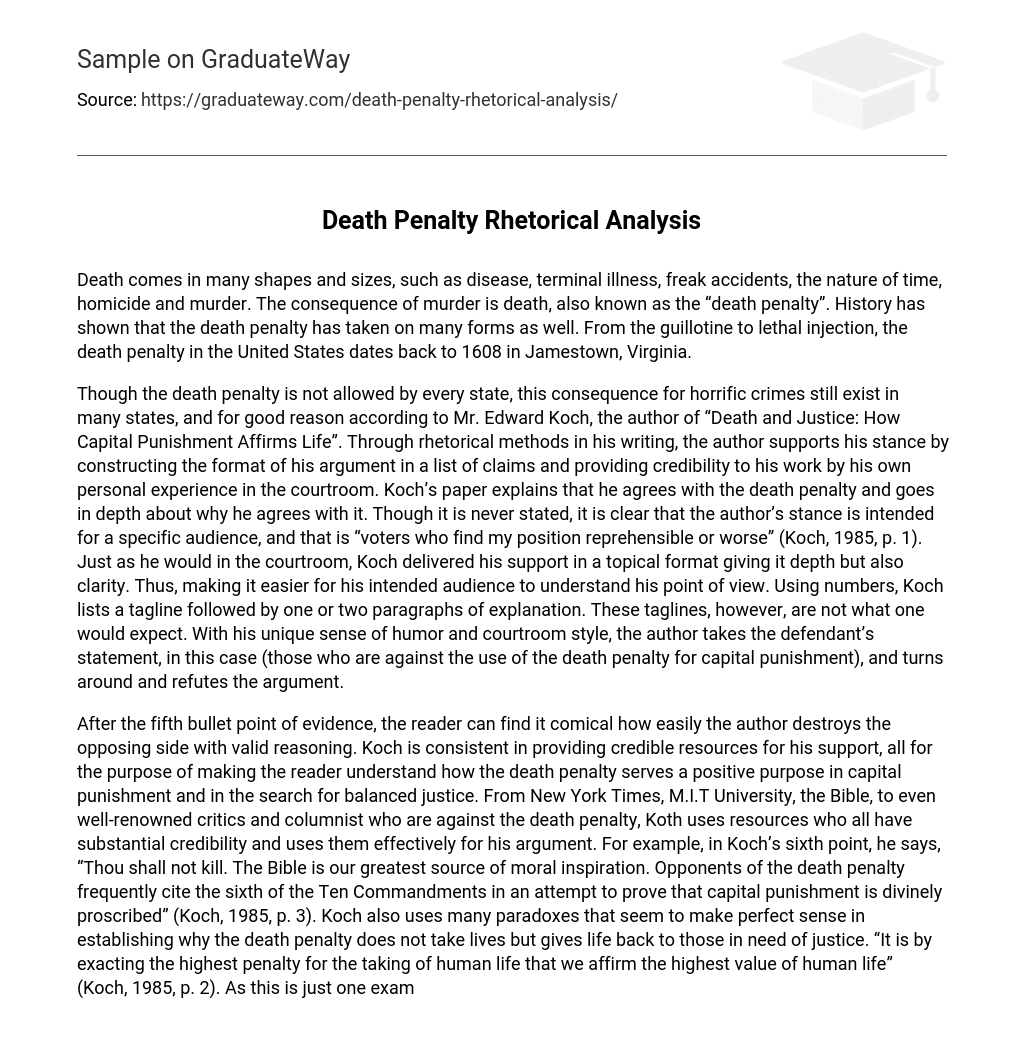Death comes in many shapes and sizes, such as disease, terminal illness, freak accidents, the nature of time, homicide and murder. The consequence of murder is death, also known as the “death penalty”. History has shown that the death penalty has taken on many forms as well. From the guillotine to lethal injection, the death penalty in the United States dates back to 1608 in Jamestown, Virginia.
Though the death penalty is not allowed by every state, this consequence for horrific crimes still exist in many states, and for good reason according to Mr. Edward Koch, the author of “Death and Justice: How Capital Punishment Affirms Life”. Through rhetorical methods in his writing, the author supports his stance by constructing the format of his argument in a list of claims and providing credibility to his work by his own personal experience in the courtroom. Koch’s paper explains that he agrees with the death penalty and goes in depth about why he agrees with it. Though it is never stated, it is clear that the author’s stance is intended for a specific audience, and that is “voters who find my position reprehensible or worse” (Koch, 1985, p. 1). Just as he would in the courtroom, Koch delivered his support in a topical format giving it depth but also clarity. Thus, making it easier for his intended audience to understand his point of view. Using numbers, Koch lists a tagline followed by one or two paragraphs of explanation. These taglines, however, are not what one would expect. With his unique sense of humor and courtroom style, the author takes the defendant’s statement, in this case (those who are against the use of the death penalty for capital punishment), and turns around and refutes the argument.
After the fifth bullet point of evidence, the reader can find it comical how easily the author destroys the opposing side with valid reasoning. Koch is consistent in providing credible resources for his support, all for the purpose of making the reader understand how the death penalty serves a positive purpose in capital punishment and in the search for balanced justice. From New York Times, M.I.T University, the Bible, to even well-renowned critics and columnist who are against the death penalty, Koth uses resources who all have substantial credibility and uses them effectively for his argument. For example, in Koch’s sixth point, he says, “Thou shall not kill. The Bible is our greatest source of moral inspiration. Opponents of the death penalty frequently cite the sixth of the Ten Commandments in an attempt to prove that capital punishment is divinely proscribed” (Koch, 1985, p. 3). Koch also uses many paradoxes that seem to make perfect sense in establishing why the death penalty does not take lives but gives life back to those in need of justice. “It is by exacting the highest penalty for the taking of human life that we affirm the highest value of human life” (Koch, 1985, p. 2). As this is just one example of the many paradoxical phrases Koch uses, the phrases seem to not make sense without the crutch of his explanation. “It is hard to imagine anything worse than being murdered while neighbors do nothing. But something worse exists. When those same neighbors shrink back from justly punishing the murderer, the victim dies twice” (Koch, 1985, p. 3).
The author ends each point with a phrase that triggers the reader to think deeply about the balance of justice versus what they considered to be morally correct. In this piece, Koch tosses up the battle between how the criminal justice system can avoid being hypocritical and finding “the cure” for the disease of injustice. His underlying purpose of this article is to answer how killing someone who has killed someone can be morally correct. Though the death penalty is a highly debated subject, Koch tactfully handled his opposers by serving their claims with contextual evidence. Not only was his textual support highly recognized, but Koch showed his own credibility through his knowledge of the criminal justice system. The style of his argument mirrored what a defense attorney would say to the prosecutor when the convicted is not guilty with proof. His style shows his experience in the courtroom, making his argument that much stronger and valid. Through these rhetorical strategies, the author effectively presents and persuades the reader to open up to the fact that the death penalty is more than killing another human being. It is a responsibility of the law enforcement to keep the Judicial system accountable. “When we protect guilty lives, we give up innocent lives in exchange” (Koch, 1985, p. 3).





